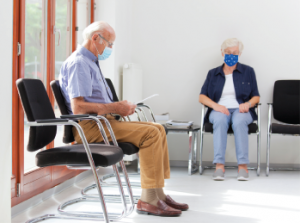
© ArtmannWitte / shutterstock.com
Prior to the novel coronavirus pandemic, Melissa Pynnonen, MD, would see about 20 patients during a typical day at the Michigan Medicine Otolaryngology Clinic in Ann Arbor. When Michigan Gov. Gretchen Whitmer issued a stay-at-home order in March, the clinic cancelled all nonurgent face-to-face appointments and transitioned to virtual care. Many patients were reluctant to use telemedicine, however, and on some days Dr. Pynnonen, who is also professor of otolaryngology at the University of Michigan, would see just two to six patients.
Explore This Issue
August 2020But since the May 29 announcement by Gov. Whitmer that nonessential medical services could resume, patients have been eager to return for in-person visits, and clinic schedules are full again. “Patients are reassured about the precautions that we’re taking to keep them safe,” she said.
Dr. Pynnonen’s experience seems like good news in light of findings from a recent report by the independent health research group Commonwealth Fund. According to the report, outpatient visits to primary care and medical specialty practices dropped by almost 60% between March 1 and March 29. Visits ticked up but were still down about 30% by May 10 (Commonwealth Fund, May 19, 2020.). The report looked at 17 specialties and found that otolaryngology was one of the most impacted by the COVID-19 pandemic—for the week of April 5, otolaryngology visits were down 75% from the baseline week of March 1. For the week of May 10, they were still down 38% from the same baseline week. Only ophthalmology experienced a larger reduction in volume.
Otolaryngologists interviewed by ENTtoday said patient volume has been increasing since March. Some said they’re fully ramped up or expect to be soon. Others acknowledged they’re seeing fewer patients, but mostly because new safety measures make it difficult to see the same number of patients as before the pandemic. All were in agreement about one thing: Patients need to be assured that it’s safe to come back.
Informing Patients about Precautions
Gavin Setzen, MD, is a partner at Albany ENT & Allergy Services in Albany, N.Y. The group, which includes 10 otolaryngologists and nine physician assistants, experienced a 90% reduction in visits in mid-March when they saw only patients with urgent cases, he said. As of June, they were seeing 80% of their pre-pandemic patient volume and expected to be at full pre-pandemic capacity by July.
Dr. Setzen definitely sees pent-up demand. “We were closed for approximately two months,” he explained. “Patients can go without care during those times, but they don’t want to delay potential new diagnoses or let existing conditions linger.”
The practice has informed patients of its many new precautions in place that are based on guidelines from the CDC and return-to-practice guidelines from the American Academy of Otolaryngology–Head and Neck Surgery that Dr. Setzen helped author (Future of Otolaryngology Task Force, Guidance for Return to Practice for Otolaryngology-Head and Neck Surgery, May 2020;). For example, staff call patients prior to their appointments to screen them for COVID-19 symptoms. Patients rarely use the waiting room; they stay in their cars until they get a text stating that an exam room is ready. Rooms are disinfected between patients, and clinicians wear varying levels of PPE, depending on the type of visit and whether or not they’ll be performing a procedure.
Dr. Setzen credited part of the increase in volume to a communication strategy the practice developed to inform patients, referring physicians, and staff that they are open and adhering to new safety standards. He said the practice’s marketing team has been sending patients text and email updates about these changes and posting about them on the practice’s website and social media accounts. Staff members have also reached out to patients to reschedule appointments that were cancelled during shelter-in-place orders.
Keith Sale, MD, vice president and chief physician executive of ambulatory services at the University of Kansas Health System in Kansas City, Kan., says his office is using Instagram, Twitter, and Facebook, as well as emails sent through their electronic health record system to reach patients. A description of new safety measures is posted on the health system’s website, kansashealthsystem.com. “Convincing patients to come back means convincing them it’s safe to be back,” he said.